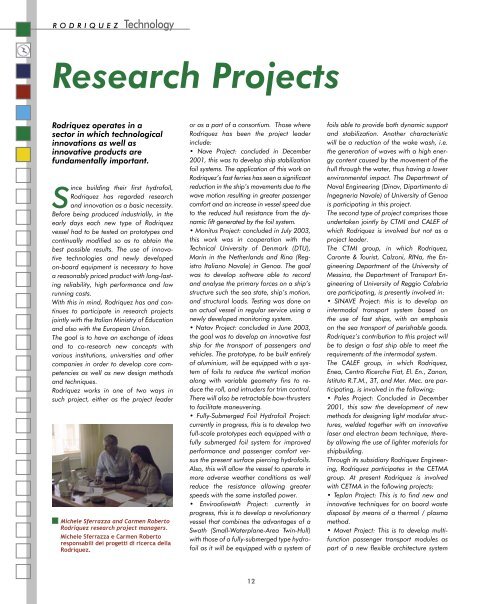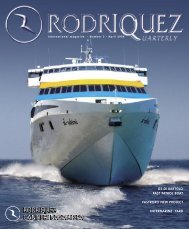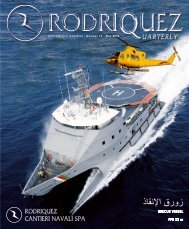Rodriquez Quarterly n. 4.pdf - RODRIQUEZ - Cantieri navali
Rodriquez Quarterly n. 4.pdf - RODRIQUEZ - Cantieri navali
Rodriquez Quarterly n. 4.pdf - RODRIQUEZ - Cantieri navali
You also want an ePaper? Increase the reach of your titles
YUMPU automatically turns print PDFs into web optimized ePapers that Google loves.
R O D R I Q U E Z Technology<br />
Research Projects<br />
<strong>Rodriquez</strong> operates in a<br />
sector in which technological<br />
innovations as well as<br />
innovative products are<br />
fundamentally important.<br />
since building their first hydrofoil,<br />
<strong>Rodriquez</strong> has regarded research<br />
and innovation as a basic necessity.<br />
Before being produced industrially, in the<br />
early days each new type of <strong>Rodriquez</strong><br />
vessel had to be tested on prototypes and<br />
continually modified so as to obtain the<br />
best possible results. The use of innovative<br />
technologies and newly developed<br />
on-board equipment is necessary to have<br />
a reasonably priced product with long-lasting<br />
reliability, high performance and low<br />
running costs.<br />
With this in mind, <strong>Rodriquez</strong> has and continues<br />
to participate in research projects<br />
jointly with the Italian Ministry of Education<br />
and also with the European Union.<br />
The goal is to have an exchange of ideas<br />
and to co-research new concepts with<br />
various institutions, universities and other<br />
companies in order to develop core competencies<br />
as well as new design methods<br />
and techniques.<br />
<strong>Rodriquez</strong> works in one of two ways in<br />
such project, either as the project leader<br />
Michele Sferrazza and Carmen Roberto<br />
<strong>Rodriquez</strong> research project managers.<br />
Michele Sferrazza e Carmen Roberto<br />
responsabili dei progetti di ricerca della<br />
<strong>Rodriquez</strong>.<br />
or as a part of a consortium. Those where<br />
<strong>Rodriquez</strong> has been the project leader<br />
include:<br />
• Nave Project: concluded in December<br />
2001, this was to develop ship stabilization<br />
foil systems. The application of this work on<br />
<strong>Rodriquez</strong>’s fast ferries has seen a significant<br />
reduction in the ship’s movements due to the<br />
wave motion resulting in greater passenger<br />
comfort and an increase in vessel speed due<br />
to the reduced hull resistance from the dynamic<br />
lift generated by the foil system.<br />
• Monitus Project: concluded in July 2003,<br />
this work was in cooperation with the<br />
Technical University of Denmark (DTU),<br />
Marin in the Netherlands and Rina (Registro<br />
Italiano Navale) in Genoa. The goal<br />
was to develop software able to record<br />
and analyse the primary forces on a ship’s<br />
structure such the sea state, ship’s motion,<br />
and structural loads. Testing was done on<br />
an actual vessel in regular service using a<br />
newly developed monitoring system.<br />
• Natav Project: concluded in June 2003,<br />
the goal was to develop an innovative fast<br />
ship for the transport of passengers and<br />
vehicles. The prototype, to be built entirely<br />
of aluminium, will be equipped with a system<br />
of foils to reduce the vertical motion<br />
along with variable geometry fins to reduce<br />
the roll, and intruders for trim control.<br />
There will also be retractable bow-thrusters<br />
to facilitate maneuvering.<br />
• Fully-Submerged Foil Hydrofoil Project:<br />
currently in progress, this is to develop two<br />
full-scale prototypes each equipped with a<br />
fully submerged foil system for improved<br />
performance and passenger comfort versus<br />
the present surface piercing hydrofoils.<br />
Also, this will allow the vessel to operate in<br />
more adverse weather conditions as well<br />
reduce the resistance allowing greater<br />
speeds with the same installed power.<br />
• Enviroaliswath Project: currently in<br />
progress, this is to develop a revolutionary<br />
vessel that combines the advantages of a<br />
Swath (Small-Waterplane-Area Twin-Hull)<br />
with those of a fully-submerged type hydrofoil<br />
as it will be equipped with a system of<br />
12<br />
foils able to provide both dynamic support<br />
and stabilization. Another characteristic<br />
will be a reduction of the wake wash, i.e.<br />
the generation of waves with a high energy<br />
content caused by the movement of the<br />
hull through the water, thus having a lower<br />
environmental impact. The Department of<br />
Naval Engineering (Dinav, Dipartimento di<br />
Ingegneria Navale) of University of Genoa<br />
is participating in this project.<br />
The second type of project comprises those<br />
undertaken jointly by CTMI and CALEF of<br />
which <strong>Rodriquez</strong> is involved but not as a<br />
project leader.<br />
The CTMI group, in which <strong>Rodriquez</strong>,<br />
Caronte & Tourist, Calzoni, RINa, the Engineering<br />
Department of the University of<br />
Messina, the Department of Transport Engineering<br />
of University of Reggio Calabria<br />
are participating, is presently involved in:<br />
• SINAVE Project: this is to develop an<br />
intermodal transport system based on<br />
the use of fast ships, with an emphasis<br />
on the sea transport of perishable goods.<br />
<strong>Rodriquez</strong>’s contribution to this project will<br />
be to design a fast ship able to meet the<br />
requirements of the intermodal system.<br />
The CALEF group, in which <strong>Rodriquez</strong>,<br />
Enea, Centro Ricerche Fiat, El. En., Zanon,<br />
Istituto R.T.M., 3T, and Mer. Mec. are participating,<br />
is involved in the following:<br />
• Pales Project: Concluded in December<br />
2001, this saw the development of new<br />
methods for designing light modular structures,<br />
welded together with an innovative<br />
laser and electron beam technique, thereby<br />
allowing the use of lighter materials for<br />
shipbuilding.<br />
Through its subsidiary <strong>Rodriquez</strong> Engineering,<br />
<strong>Rodriquez</strong> participates in the CETMA<br />
group. At present <strong>Rodriquez</strong> is involved<br />
with CETMA in the following projects:<br />
• Teplan Project: This is to find new and<br />
innovative techniques for on board waste<br />
disposal by means of a thermal / plasma<br />
method.<br />
• Mavet Project: This is to develop multifunction<br />
passenger transport modules as<br />
part of a new flexible architecture system





